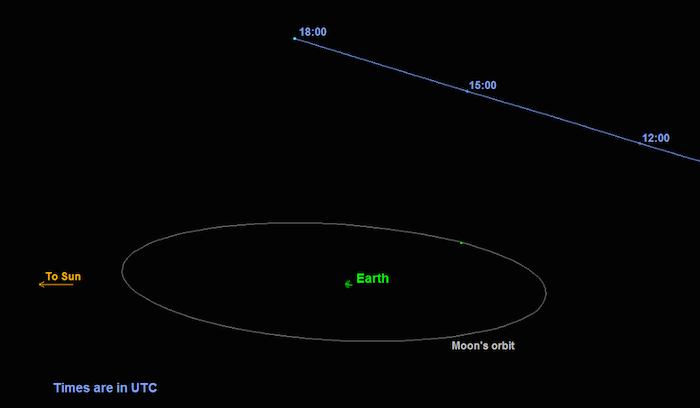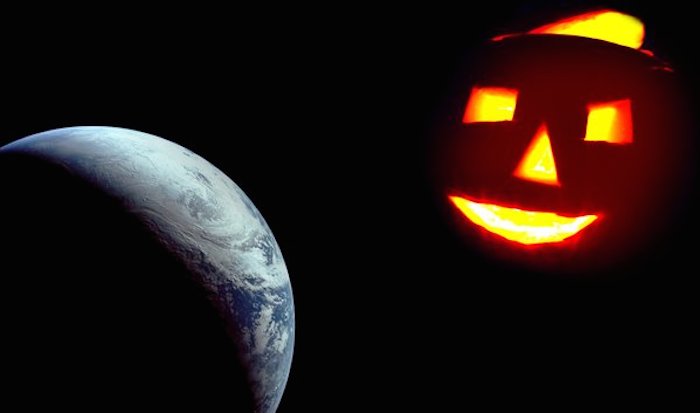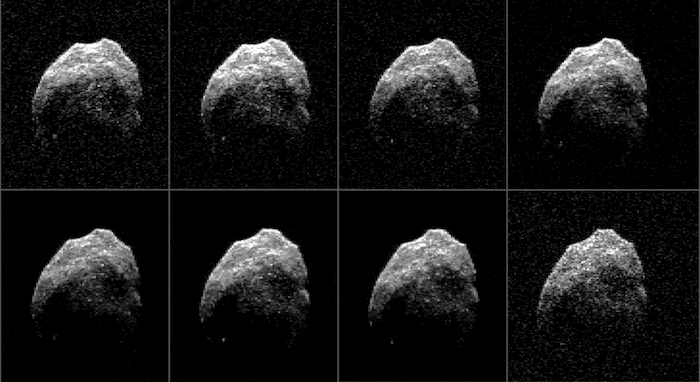.
22.10.2015

This is a graphic depicting the orbit of asteroid 2015 TB145. The asteroid will safely fly past Earth slightly farther out than the moon's orbit on Oct. 31 at 10:05 a.m. Pacific (1:05 p.m. EDT and 17:05 UTC).
Credits: NASA/JPL-Caltech
NASA scientists are tracking the upcoming Halloween flyby of asteroid 2015 TB145 with several optical observatories and the radar capabilities of the agency's Deep Space Network at Goldstone, California. The asteroid will fly past Earth at a safe distance slightly farther than the moon's orbit on Oct. 31 at 10:05 a.m. PDT (1:05 p.m. EDT). Scientists are treating the flyby of the estimated 1,300-foot-wide (400-meter) asteroid as a science target of opportunity, allowing instruments on "spacecraft Earth" to scan it during the close pass.
Asteroid 2015 TB145 was discovered on Oct. 10, 2015, by the University of Hawaii's Pan-STARRS-1 (Panoramic Survey Telescope and Rapid Response System) on Haleakala, Maui, part of the NASA-funded Near-Earth Object Observation (NEOO) Program. According to the catalog of near-Earth objects (NEOs) kept by the Minor Planet Center, this is the closest currently known approach by an object this large until asteroid 1999 AN10, at about 2,600 feet (800 meters) in size, approaches at about 1 lunar distance (238,000 miles from Earth) in August 2027.
“The trajectory of 2015 TB145 is well understood," said Paul Chodas, manager of the Center for Near Earth Object Studies at NASA's Jet Propulsion Laboratory, Pasadena, California. "At the point of closest approach, it will be no closer than about 300,000 miles -- 480,000 kilometers or 1.3 lunar distances. Even though that is relatively close by celestial standards, it is expected to be fairly faint, so night-sky Earth observers would need at least a small telescope to view it."
The gravitational influence of the asteroid is so small it will have no detectable effect on the moon or anything here on Earth, including our planet's tides or tectonic plates.
The Center for NEO Studies at JPL is a central node for NEO data analysis in NASA’s Near-Earth Object Observation Program and a key group involved with the international collaboration of astronomers and scientists who keep watch on the sky with their telescopes, looking for asteroids that could be a hazard to impact our planet and predicting their paths through space for the foreseeable future.
"The close approach of 2015 TB145 at about 1.3 times the distance of the moon’s orbit, coupled with its size, suggests it will be one of the best asteroids for radar imaging we’ll see for several years," said Lance Benner, of JPL, who leads NASA's asteroid radar research program. "We plan to test a new capability to obtain radar images with two-meter resolution for the first time and hope to see unprecedented levels of detail."
During tracking, scientists will use the 34-meter (110-foot) DSS 13 antenna at Goldstone to bounce radio waves off the asteroid. Radar echoes will in turn be collected by the National Radio Astronomy Observatory’s Green Bank Telescope in Green Bank, West Virginia, and the National Astronomy and Ionosphere Center's Arecibo Observatory, Puerto Rico. NASA scientists hope to obtain radar images of the asteroid as fine as about 7 feet (2 meters) per pixel. This should reveal a wealth of detail about the object's surface features, shape, dimensions and other physical properties.
“The asteroid's orbit is very oblong with a high inclination to below the plane of the solar system," said Benner. "Such a unique orbit, along with its high encounter velocity -- about 35 kilometers or 22 miles per second -- raises the question of whether it may be some type of comet. If so, then this would be the first time that the Goldstone radar has imaged a comet from such a close distance."
NASA’s Near-Earth Object Observations Program detects, tracks and characterizes asteroids and comets passing within 30 million miles of Earth using both ground- and space-based telescopes. The NEOO Program, sometimes called "Spaceguard," discovers these objects, characterizes the physical nature of a subset of them, and predicts their paths to determine if any could be potentially hazardous to our planet. There are no known credible impact threats to date -- only the ongoing and harmless in-fall of meteoroids, tiny asteroids that burn up in the atmosphere.
JPL hosts the Center for Near-Earth Object Studies for NASA's Near-Earth Object Observations Program within the agency's Science Mission Directorate. JPL is a division of the California Institute of Technology in Pasadena.
Quelle: NASA
-
Update: 29.10.2015
.
HALLOWEEN ASTEROID:
An asteroid the size of a battleship will fly past the Earth-Moon system on Oct. 31st. There's no danger of a collision. Asteroid 2015 TB145 will be 300,000 miles away from Earth at closest approach on Halloween. That's too far for goosebumps, but close enough for a good view. NASA radar astronomers plan to make high-resolution maps of the passing space rock.
At the moment, 2015 TB145 is still a dim speck in the southern constellation Eridanus. Amateur astronomer Marian Urbanik photographed it on Oct. 26th using a remotely controlled 0.43 meter telescope in Siding Springs, Australia:
.

When Urbanik took the picture, the asteroid was shining like a 16th magnitude star. By the time it reaches the Earth-Moon system on Halloween, it will have brightened 250-fold to 10th magnitude. That's too dim for the naked eye, but an easy target for experienced astronomers with mid-sized backyard telecopes. An article from Sky & Telescope discusses the asteroid's visibility.
2015 TB145 is about 400 meters wide. According to the Minor Planet Center, this is the closest known approach by an object this large until asteroid 1999 AN10 (800 meters wide) approaches Earth at a distance of 238,000 miles in August 2027.
Lance Benner, a radar astronomer at JPL, has raised the intriguing possibility that 2015 TB145 is not an asteroid. "The asteroid's orbit is very oblong with a high inclination to below the plane of the solar system," said Benner. "Such a unique orbit, along with its high encounter velocity -- about 35 kilometers or 22 miles per second -- raises the question of whether it may be some type of comet. If so, then this would be the first time that the Goldstone radar has imaged a comet from such a close distance."
Quelle: Spaceweather
---

DLR_next @DLR_
Soeben erreichen uns erste Aufnahmen des sog. Halloween-Asteroiden 2015 TB145. ++ Wir prüfen noch die Echtheit.
---
Update: 31.10.2015
.
Webcast will capture Halloween asteroid flyby
The Earth will have its closest encounter with an asteroid in more than a decade this Halloween, as a so-called Near Earth Object zooms safely by the planet on Saturday. The asteroid is expected to pass by at 1:01 p.m. ET.
NASA scientists are currently tracking the asteroid's path using the optical observatories and radar abilities of its Deep Space Network at Goldstone, California, according to a NASA press release.
While it has been nicknamed both "Spooky" and the "Great Pumpkin," the rock's official name is the less festive "2015 TB145." Experts say it will shoot past Earth at a distance of about 300,000 miles -- about 1.3 times the distance of the moon's orbit.



Its close approach, "coupled with its size, suggests it will be one of the best asteroids for radar imaging we'll see for several years," said Lance Benner, of NASA's Jet Propulsion Laboratory, who leads the asteroid radar research program.
The asteroid was discovered earlier this month, and astronomers have been gathering images of it to learn more about its orbit, size, and speed.
If you want to catch a glimpse before you head out for trick-or-treating, the online Slooh Community Observatory will provide a live webcast of the event starting at 12:30 p.m ET Saturday.
Spooky is about the size of a football stadium, but NASA researchers have emphasized that this space rock -- much like Casper -- is friendly and poses no danger.
Quelle: CBS-News
---
Update:
.
Near-Earth Asteroid 2015 TB145 passes by without a fright!
Scientists from the Planetary Radar Group at the Arecibo Observatory, facility of the National Science Foundation (NSF), observed near-Earth asteroid 2015 TB145 on the eve of Halloween, October 30, 2015. The NASA-funded planetary radar system measured 2015 TB145 to be about 600 meters (1,968.5 feet) in diameter, which is much larger than expected, with a rotation of approximately 5 hours and velocity of 35 km per second.
This asteroid, discovered on October 10, will make its closest approach to Earth on the morning of Halloween, October 31, 2015, when it is 1.3 times farther away from Earth than the Moon. Observers with small telescopes may catch a glimpse of Asteroid 2015 TB145 near the constellation Ursa Major.
Observations of this asteroid were also conducted jointly with other radio telescopes across the United States, including NASA Jet Propulsion Laboratory’s Goldstone Solar System Radar and National Radio Astronomy Observatory’s Green Bank Telescope and Very Long Baseline Array. Data from these observations will be used to determine the asteroid’s shape, rotation, and surface properties as well as allow for refinement of the asteroid’s orbit, which can be used to better assess its impact hazard. The Arecibo Observatory will also observe this asteroid on Halloween Day.
Asteroid 2015 TB145 was recently discovered by the Pan-STARRS I survey in Hawaii and classified as a potentially hazardous asteroid due to its size and relative proximity to Earth. “One of the directives of the Arecibo Observatory is to measure with high precision the distance to asteroids and their speed, which can be used to study the asteroid’s orbit and predict its motion for hundreds of years,” said Dr. Edgard Rivera-Valentin, a Universities Space Research Association (USRA) Planetary Scientist at the Arecibo Observatory. Tracking of 2015 TB145 has shown that it is not a threat and will not have a similarly close approach to Earth during this century.
“Our measurements also allow for high-resolution images surpassed only by dedicated space missions sent to asteroids. The difference is our work is much more cost efficient and can survey many times more asteroids,” added Dr. Patrick Taylor, USRA Group Lead for the Planetary Radar Group.
Radar images obtained at the Arecibo Observatory appear to rotate clockwise, which is noticeable by the movement of bright features. “The bright and dark features are indication of surface irregularities. For example, the central dark feature may be a large circular depression, possibly an impact crater”, commented Dr. James Richardson, USRA Scientist in the Planetary Radar Group.
The Arecibo Observatory has observed over 80 asteroids so far this year and will continue to monitor the skies to improve our understanding of the impact hazard objects such as Asteroid 2015 TB145 pose to Earth.
Located in Puerto Rico, the Arecibo Observatory is home to the largest and most sensitive single dish radio telescope in the world. The Arecibo Observatory is operated by SRI International in partnership with Ana G. Méndez University System-Universidad Metropolitana and Universities Space Research Association (USRA) under a cooperative agreement with the NSF. The Arecibo Planetary Radar program is supported by NASA's Near Earth Object Observation program.
.

Arecibo radar images of asteroid 2015 TB145 with resolution of 7.5 meters (25 feet). The frames are snapshots throughout the 40-minute-long observation. Bright features on the surface appear to rotate clockwise from image to image. The darker features may be depressions on the surface.
Quelle: Arecibo Observatory
-
Update: 14.50 MEZ
.
Halloween Skies to Include Dead Comet Flyby

This animated GIF was generated using radar data collected by the National Science Foundation's 1,000-foot (305-meter) Arecibo Observatory in Puerto Rico. The six radar images used in the animation were taken on Oct. 30, 2015, and the image resolution is 25 feet (7.5 meters) per pixel.
Credits: NAIC-Arecibo/NSF
.
The large space rock that will zip past Earth this Halloween is most likely a dead comet that, fittingly, bears an eerie resemblance to a skull.
Scientists observing asteroid 2015 TB145 with NASA's Infrared Telescope Facility (IRTF) on Mauna Kea, Hawaii, have determined that the celestial object is more than likely a dead comet that has shed its volatiles after numerous passes around the sun.
The belated comet has also been observed by optical and radar observatories around the world, providing even more data, including our first close-up views of its surface. Asteroid 2015 TB145 will safely fly by our planet at just under 1.3 lunar distances, or about 302,000 miles (486,000 kilometers), on Halloween (Oct. 31) at 1 p.m. EDT (10 a.m. PDT, 17:00 UTC).
The first radar images of the dead comet were generated by the National Science Foundation's 305-meter (1,000-foot) Arecibo Observatory in Puerto Rico. The radar images from Arecibo indicate the object is spherical in shape and approximately 2,000 feet (600 meters) in diameter and completes a rotation about once every five hours.
"The IRTF data may indicate that the object might be a dead comet, but in the Arecibo images it appears to have donned a skull costume for its Halloween flyby," said Kelly Fast, IRTF program scientist at NASA Headquarters and acting program manager for NASA's NEO Observations Program.
Managed by the University of Hawaii for NASA, the IRTF's 3-meter (10 foot) telescope collected infrared data on the object. The data may finally put to rest the debate over whether 2015 TB145, with its unusual orbit, is an asteroid or is of cometary origin.
Quelle: NASA
-
Update: 3.11.2015
.
Radar Images Provide New Details on Halloween Asteroid

Asteroid 2015 TB145 is depicted in eight individual radar images collected on Oct. 31, 2015 between 5:55 a.m. PDT (8:55 a.m. EDT) and 6:08 a.m. PDT (9:08 a.m. EDT). At the time the radar images were taken, the asteroid was between 440,000 miles (710,000 kilometers) and about 430,000 miles (690,000 kilometers) distant. Asteroid 2015 TB145 safely flew past Earth on Oct. 31, at 10:00 a.m. PDT (1 p.m. EDT) at about 1.3 lunar distances (300,000 miles, 480,000 kilometers).
Credits: NASA/JPL-Caltech/GSSR/NRAO/AUI/NSF
Full image and caption
The highest-resolution radar images of asteroid 2015 TB145's safe flyby of Earth have been processed. NASA scientists used giant, Earth-based radio telescopes to bounce radar signals off the asteroid as it flew past Earth on Oct. 31 at 10 a.m. PDT (1 p.m. EDT) at about 1.3 lunar distances (300,000 miles, or 480,000 kilometers) from Earth. Asteroid 2015 TB145 is spherical in shape and approximately 2,000 feet (600 meters) in diameter.
"The radar images of asteroid 2015 TB145 show portions of the surface not seen previously and reveal pronounced concavities, bright spots that might be boulders, and other complex features that could be ridges," said Lance Benner of NASA's Jet Propulsion Laboratory in Pasadena, California, who leads NASA's asteroid radar research program. "The images look distinctly different from the Arecibo radar images obtained on Oct. 30 and are probably the result of seeing the asteroid from a different perspective in its three-hour rotation period."
o obtain these highest-resolution radar images of the asteroid, scientists used the 230-foot (70-meter) DSS-14 antenna at Goldstone, California, to transmit high-power microwaves toward the asteroid. The signal bounced off the asteroid, and its radar echoes were received by the National Radio Astronomy Observatory’s 100-meter (330-foot) Green Bank Telescope in West Virginia. The radar images achieve a spatial resolution as fine as 13 feet (4 meters) per pixel.
"Working with our observatory partners, we were able to get our resolution down to less than 13 feet (four meters) per pixel," said Shantanu Naidu, a postdoctoral student at the California Institute of Technology in Pasadena, and a member of the radar team. "It is a truly remarkable achievement—one which we will later be able to apply when future flyby opportunities present themselves."
The next time that asteroid 2015 TB145 will be in Earth's neighborhood will be in September 2018, when it will make a distant pass at about 24 million miles (38 million kilometers), or about a quarter the distance between Earth and the sun.
Radar is a powerful technique for studying an asteroid's size, shape, rotation, surface features and surface roughness, and for improving the calculation of asteroid orbits. Radar measurements of asteroid distances and velocities often enable computation of asteroid orbits much further into the future than would be possible otherwise.
NASA places a high priority on tracking asteroids and protecting our home planet from them. In fact, the U.S. has the most robust and productive survey and detection program for discovering near-Earth objects (NEOs). To date, U.S. assets have discovered about 98 percent of known NEOs.
In addition to the resources NASA puts into understanding asteroids, it also partners with other U.S. government agencies, university-based astronomers, and space science institutes across the country, often with grants, interagency transfers and other contracts from NASA, and also with international space agencies and institutions that are working to track and better understand these objects. In addition, NASA values the work of numerous highly skilled amateur astronomers, whose accurate observational data helps improve asteroid orbits after they are found.
JPL hosts the Center for Near-Earth Object Studies for NASA's Near-Earth Object Observations Program within the agency's Science Mission Directorate.
Quelle: NASA
4412 Views
